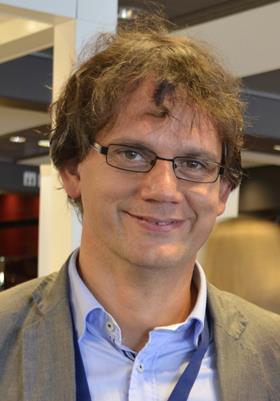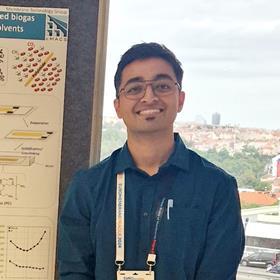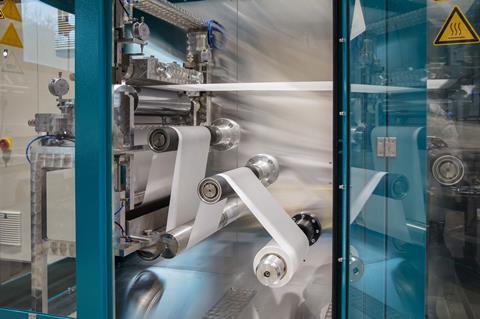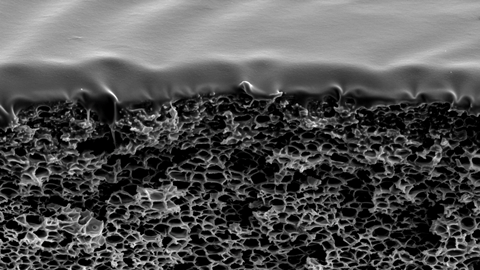To help make the agricultural sector more sustainable, a team from KU Leuven designed a membrane with a green solvent strategy for biogas purification. ‘We’re not aiming at maximum process efficiency, but rather maximum affordability.’
Since governments, companies and research is increasingly moving away from fossil fuels, many researchers look at biogas as a viable alternative. Biogas is a byproduct of many agricultural activities and is often simply burned for heat or power. To make more efficient use of the valuable molecules hidden in the gas, you could purify it with membranes.

One of the ways to make these membranes is via non-solvent induced phase separation (NIPS). ‘It’s a process where a polymer solution is turned into a solid, porous material by contact with a non-solvent’, explains Ivo Vankelecom, full professor at the Faculty of Bioscience Engineering at the KU Leuven. Vankelecom, Amit Shenoy and colleagues designed such a membrane using polyimide Matrimid 5218s combined with green solvents, they report in the Journal of Membrane Science.
Green
‘Conventionally, these polyimide-membranes are made with solvents like DMF or NMP’, says Shenoy, PhD student in Vankelecom’s group. ‘Though these are very common and work great for dissolving polyimides, the great downside is that they are not always safe to use.’ In the fabrication process, you end up with a lot of solvent-water waste. ‘The waste is harmful for aquatic life and potentially dangerous for operators when not handled with care’, Shenoy continues. ‘We chose a combination of solvents that are less toxic to the environment and less harmful for operators.’

These solvents – dimethyl sulphoxide (DMSO), methyl-THF and Tamisolve® - can be considered green, according to Vankelecom. ‘Green is a very broad term in chemistry. There are twelve principles in which a chemical or process can be green, like the environment, toxicity, volatility et cetera. These three solvents are green in at least one of these aspects.’ Shenoy adds: ‘Tamisolve® is considered non-reprotoxic, meaning that it’s not harmful for reproductive life. DMSO and methyl-THF are both biodegradable, and the latter is also biobased.’
Coffee filter
It wasn’t easy to get the green solvents to work. ‘Though there is a lot of literature on polyimides, when you change the standard solvents, it becomes an entirely new synthesis environment’, Shenoy explains. ‘And some of these green solvents have only recently become well available, there was practically no literature we could base our work on.’ This meant the Leuven team not only had to develop their protocol nearly from scratch, they also had to investigate the fundamental scientific concepts that were at play. ‘We needed to know what was happening between the polymer, the non-solvent and the solvents.’
There was a thin line to thread. ‘Membranes for biogas purification need to have really tiny pores to separate gas molecules like methane or carbon dioxide’, says Vankelecom. ‘So we had to be careful with our NIPS protocol; all the different parts can behave quite erratically, which could give you a membrane with nanopores or something akin to a coffee filter.’
article proceeds below the image

Industrial level
Although the publication is quite recent, the team has been working hard on this membrane type for a couple of years now. Vankelecom: ‘In this paper, we show our understanding of the system, but in the background we have been looking at upscaling and marketing our invention. We already have a few spots where we can test the membranes, to see how they behave in a real environment compared to the lab.’ These pilot tests will start in a couple of weeks.
Shenoy has been in charge of upscaling and testing the membrane. ‘That was a real highlight for me’, he says. ‘We’ve worked with this membrane in the lab for quite a while, but working at pilot scale is very different. For this, we used our so-called Smart Coater, which can do NIPS via a continuous roll-to-roll procedure on a large scale, which makes the synthesis more appropriate for the industrial level.’
The team has been working with the research institute Inagro which ferments organic waste from the local agriculture. In addition, colleagues from the VUB in Brussels, who focus on further purification of biogas through adsorption, are part of this FWO-SBO project. ‘We want to see if our membranes can perform the biogas purification on their own or if they need the adsorption technology which is developed at the VUB to reach the final purification goals’, the Leuven Professor clarifies.
Overall, the aim of this research is to make a very cheap system that is able to operate even at farm scale. ‘At this time, we’re not aiming at the very large industrial operations, but at smaller and more local farms or grouped farms’, says Vankelecom. ‘Therefore, we are not aiming at maximum process efficiency, but rather maximum affordability and ease of use. That’s the niche we’re looking for.’
Shenoy, A.M. et al. (2025) J. Mem. Sci. 717, DOI: 10.1016/j.memsci.2024.123573













Nog geen opmerkingen